Module 4
1/174
There's no tags or description
Looks like no tags are added yet.
Name | Mastery | Learn | Test | Matching | Spaced |
|---|
No study sessions yet.
175 Terms
what is pathogen
a disease-causing microorganism
types of pathogens
bacteria
virus
fungi
protists
what is a communicable disease
diseases caused by pathogens- can spread
bacteria
prokaryote
produce toxins and damage cells
in plants, they live in vascular tissue
not all bacteria are pathogens
virus
non-living→ genetic material surrounded by a protein
infect cells by incorporating its own genetic material into DNA of a cell
viruses multiply and burst out of the cell→ goes on to infect other cells
fungi
eukaryotic
produce spores that can infect other organisms
bodies consists of filaments called hyphae
form network a spread thru host/soil
protists
eukaryotic
uni or multicellular
enter host, feed on host contents as they grow
often require vector to transfer
bacterial diseases
tuberculosis:
infects lungs→ causes chronic cough and bloody mucus
kills cells and tissues
M. bovine in cows can transmit to humans to cause TB
spread: airborne droplets
Bacterial Meningitis:
infection of the meninges→ membranes surrounding brain and spinal cord
causes fever, headache, rash, neck stiffness→ can cause brain and nerve damage
spread: airborne droplets
Ring rot:
infect vascular tissue→ prevents transport of water so plant wilts and dies
spreads into potato tubers→ produces black ring of rot
spread: contact with infected plants
viral infections
influenza:
infect cells that line airways
cause high temp, body aches, fatigue
spread: airborne droplets
HIV/AIDS:
retrovirus→ have ability to make DNA from its RNA
DNA inserted into host→ can remain inactive for many years
compromises immune system→ AIDS
spread: transfer of body fluids (STI)
Tobacco Mosaic Virus:
Causes mottling and discolouration of leaves
spread: contact with contaminated plants
Protist Infections
Blight:
transmitted via spores
causes brown marks on leaves which increase in size and number
protist destroys potato and tomato crops
malaria:
spread by mosquitos
causes fever, chills, fatigue→ fatal
Fungal infections
Ringworm:
affect cattle
growth of fungus in skin with spore cases erupting through skin to cause rash
athletes foot:
growth of fungus under skin of feet- usually between toes
Black Sigatoka:
affects bananas
reduces ability of plant to photosynthesise
causes parts of the leaf to die→ black streaks
eventually causes death
types of transmission of disease (with e.gs)
direct contact→ from one host to another:
spores
airborne transmission
exchange of bodily fluids
direct contact
indirect contact→ second organism transfers it to new host:
vectors
factors affecting disease transmission
poor ventilation
contact with people who have migrated from areas where disease is common
socio-economic factors
poor nutrition
damp warm conditions→ ideal living conditions for pathogens
compromised immune sytem
poor waste disposal
poor hygiene
types of defences in plants
passive defences:
present before infection
prevent entry and spread of pathogen
physical and chemical defences
active defences:
when pathogens attack
plants will fortify existing defences when attacked
physical defences in plants (7)
cellulose cell walls:
physical barrier
contains variety of chemical defences→ activated with pathogen detected
lignin:
thickening of cell walls→ waterproofing of cell walls
waxy cuticle:
prevents water collecting on surface
no water= pathogen can’t survive
bark:
prevents entry of pathogens
contains chemicals that work against pathogens
stomatal closure:
when pathogens detected, guard cells close stomata in that part of the plant
callose:
large polysaccharide deposited in sieve tubes
blocks flow of sieve tubes
pathogen prevented from travelling through plant via phloem
tylose:
balloon-like swelling which fills xylem vessel→ plugs xylem so cannot carry water so stops spread of pathogens
contains high conc. of chemicals which are toxic to pathogens
chemical defences in plants
produce chemicals with anti pathogenic properties
terpenes in tyloses
tannins in bark
active defences in plants
cell walls thickened→ additional cellulose added to strengthen them
deposition of callose between cell wall and cell membrane near invading pathogen→ impedes cellular penetration, blocks plasmodesmata
oxidative bursts→ reactive oxygen molecules that can damage pathogenic cells
necrosis→ deliberate cell suicide to limit pathogens access to water
primary defences
prevent pathogen entry
primary defences in humans
skin:
acts as physical barrier
has antimicrobial substances
blood clotting:
uses calcium and 12 clotting factors→ released from platelets
factors activate enzyme cascade
mucus membrane:
line exchange surfaces
ciliated epithelial cells waft pathogens into mucus to be swallowed and destroyed
wax:
e.g. in ears→ trap pathogens
lysozyme:
enzyme that destroys pathogen by disrupting cell wall
acid:
e.g. in stomach and vagina to kill pathogens
inflammation:
mast cells (detect pathogens) release histamines
causes vasodilation and causes capillary walls to be more permeable to WBCs
fevers:
body temp raised to kill/destroy pathogen
helps activate immune system
what is an antigen
glycolipids or glycoproteins that initiate an immune response
opsonins
proteins that bind to antigens on a pathogen to enhance a phagocyte’s ability to bind to and engulf the pathogen
types of phagocytes
neutrophils
macrophages
neutrophils
multi-lobed nucleus
travel in blood and move out of blood into tissue fluid
die soon after digested pathogen (pus)
made in large numbers when infection present
macrophages
kidney shapes nucleus
larger cells
travel in blood as monocytes and settle in lymph nodes, where they mature into macrophages
have a role in specific response
what is phagocytosis
neutrophils and macrophages engulf and digest pathogens
the process of phagocytosis
phagocyte receptors recognise opsonin’s antibody/antigen on surface as foreign
cytoplasm of phagocyte engulfs pathogen
pathogen is contained within phagocytic vacuole in cytoplasm
lysosome fuses with phagocytic vacuole→ releases lysozyme, which breaks down pathogen
Antigen presentation
Macrophages only partially digest pathogen
Antigen of pathogen is brought to cell surface membrane to trigger full immune response from T and B cells
The specific immune response
Antigen is presented on cell by macrophage
Specific B and T lymphocytes are recruited and are complementary to the antigen→ bind to the antigens
T cells divide by mitosis and differentiate to make variants of T cells→ clonal expansion
T helper cells release cytokines, which activate B cells
B cells divide by mitosis (clonal expansion) and differentiate to make plasma cells and B memory cells
T and B memory cells made and stored.
Result of the specific immune response
Produces antibodies→ neutralise foreign antigens
Provides immunological memory
T-cell mediated immunity
When T cells have been recruited the bind to the antigen on the APC
Divide by mitosis into clones
Differentiate into:
T-killer cells: directly kills other cells by putting holes in the membranes
T- helper cells→ stimulates more phagocytosis by releasing cytokines and activate B cells by releasing cytokines to produce antibodies
T-memory cells→ develop into memory cells providing long term immunity
T-regulator cells→ shut down immune response once pathogen has been removed
B cell/ Humoral Immunity
involves soluble antibodies in body fluid
By lymphocytes develop into either:
B plasma cells→ circulate in blood, make and release antibodies
B memory cells→ remain in body to provide immunological memory
difference between primary and secondary immune responses
secondary is much quicker and stronger due memory cells
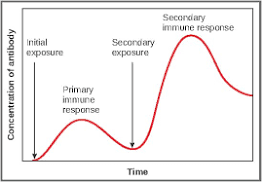
autoimmune diseases
immune system stops recognising self antigens→ attacks health body tissues
often requires use of immunosuppressant drugs to prevent immune system from working
examples of autoimmune diseases
arthritis:
inflammation of joints
antibodies attack membranes around the joint
lupus:
antibodies attack proteins in nucleus of cells and affect tissue
what is an antibody
a molecule which is produced by lymphocytes in response to infection
have quaternary structure
bind to antigens on the surface of the pathogen to form antigen-antibody complexes
structure of anitbodies
quaternary structure of 4 polypeptides
specificity of antibody depends on its variable regions→ form antigen binding sites
variable regions have unique tertiary structure→ complimentary to specific antigen
all antibodies have the same constant region
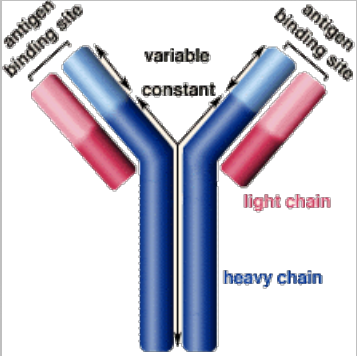
types of antibodies
opsonins
agglutinins
anti-toxins
opsonins
bind to antigens on pathogens
act as binding site for phagocytes→ can more easily bind and destroy the pathogen
may bind to antigen molecules that would otherwise bind to host cells→ antigen is useless and pathogen cannot enter cell→ neutralisation
agglutinins
two binding sites of antibody bind to antigens on different pathogens- crosslinks pathogens
clumps pathogens together→ makes it easier to engulf and digest them
antitoxins
bind to molecules released by pathogenic cells and render them harmless
what is immunity
the ability to resist infection
types of immunity
passive:
caused by introduction of antibodies from an outside source
short lasting→ not being replaced when they are broken down
natural→ breast milk
artificial→ injection with antibodies
active immunity:
caused by the production of antibodies by the individual’s own immune system
loner lasting
natural→ immune response
artificial→ forms the basis of vaccination
vaccination
provides immunity against a specific pathogen
injection or orally administered antigenic material
immune system makes antibodies and memory cells to antigens
antigenic material used in vaccines
whole organisms
weakened version of pathogen
preparation of antigens from pathogen
toxin from the pathogen
why are new drugs needed
new diseases
some diseases have no treatment
some antibiotics are no longer effective
traditional remedies
morphine:
comes from sap of unripe poppy seed heads
opium used as anaesthetic in 12th century
acts on nervous system→ no pain felt
aspirin:
willow bark extract→ relieve pain and fever
modifies to stop stomach bleeding
led to development of aspirin and ibuprofen
Observation of wildlife:
monkeys/ bears rub citrus oils into coats as insecticide
birds line nests with medicinal leaves to protect from mites
research into disease causing mechanisms
research carried out to find out how pathogens cause disease e.g. HIV binds to CD4 receptors of T helper→ if this is prevented, HIV can be stopped from infecting cells
personalised medicine
genome of plants/microorganisms screened to identify medicinal compounds from DNA sequence
potential to sequence human DNA with specific conditions and develop specific drugs for them
synthetic biology
development of new molecules→ particularly enzymes
antibiotic resistance
antibiotics create selection pressures on population of bacteria
variation exists in the population due to random mutation
most bacteria killed by antibiotic→ some resistant species survive
resistant species survive and reproduce→ more of resistant species
What is biodiversity
The range and variety of alleles, species and habitats in an ecosystem
Importance of biodiversity
Maintains equilibrium of an ecosystem
All ecosystems are interdependent→ if biodiversity was reduced, there wouldn't be links between interdependent organisms
Components of biodiversity
Species diversity
Genetic diversity
Ecosystem diversity
What is species diversity
Number of different species and number of individuals of each species within any one community
What is ecosystem diversity
The range of different habitats within a particular area
Lots of habitats= high ecosystem diversity
What is genetic diversity
The number of different alleles within a population
Components of species diversity
Species richness
Species evenness
Species richness
Number of different species living in a ecosystem
Species evenness
The number of individuals of each species living in a community
Purpose of sampling
Difficult/ inefficient to count all organisms in one area
Sampling allows for representative estimate
Distribution
Presence or absence of each species
Where they all are
Abundance
Frequency:
the likelihood of an organism occurring in a quadrat
Does not tell us density of
Percentage cover:
Estimates area in quadrant covered by particular species→ useful when difficult to count
Difficult when there is species overlap
Random sampling
Individual organisms selected by chance→ every organism has equal chance of being selected
Non-random sampling
Sample not chosen at random→ involves element of choice
Random sampling+ pros and cons
Sample sites randomly selected i.e. number generator
Advantages:
Data is not biased
Disadvantages:
Not cover all areas of habitat equally→ species with lower presence may be missed, underestimated
Opportunistic sampling+ pros and cons
Researcher makes decisions based on prior knowledge→ may deliberately sample an area that they know contains certain species
Advantages:
Easier and quicker than random sampling
disadvantages:
May be biased→ overestimate of biodiversity
stratified sampling+ pros and cons
dividing habitat into areas which appear different
Advantages:
ensure all habitats are sampled and nothing is missed
disadvantages:
over-representation→ if some of the areas are smaller than others, there may be a disproportionate number of samples taken
systematic/ transect sampling+ Pros and Cons
samples take at fixed intervals across a habitat
Advantages:
useful when showing change from one area to another
Disadvantages:
only species on line or within the belt will be counted
species can be missed→ underestimate
Types of transects
line transects:
record which species are touching the tape measure at regular intervals
quicker→ useful for determining distribution
belt transects:
place a quadrat next to the tape
continuous→ quadrats placed along full length of tape
interrupted→ quadrats placed at regular intervals along tape
provides more detailed data on abundance
reducing effects of sampling bias
create a grid and use random number generator to generate coordinates
use larger sample size→ identify and eliminate anomalous results
methods of sampling animals (6)
pooter
pitfall trap
sweep nets
tree beating
kick sample
tullgren funnel
pooter
device used to sample small insects
sucking on a mouthpiece that draws the insect into a chamber through inlet tube
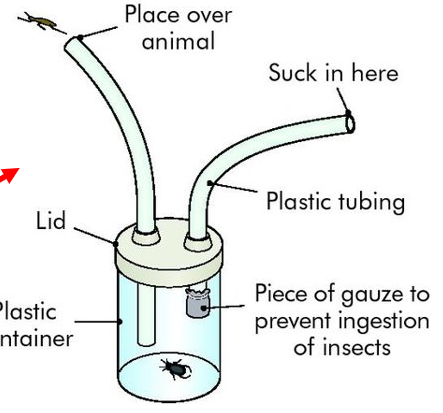
pitfall traps
hole dug into the ground→ insects fall into hole
covered by roof structure to stop rainwater entering
can be left overnight to sample nocturnal species
used to trap small crawling invertebrates e.g. spiders, beetles
sweep nets
hand held nets that are swept across an area
used to capture insects in areas of long grass
tree beating
takes samples of invertebrates in a tree or bush
sheet spread underneath and tree/ bush is shaken/ hit to dislodge species that fall into sheet
kick sampling
done in stream/ river to measure invertebrates
stream/ river bank kicked to disturb substrate
net held downstream to capture any dislodged invertebrates
tullgren funnel
litter spread on mesh screen within a large funnel with light bulb suspended above the litter
combination of heat, light and drying of litter drives insects through the mesh→ drop into container at bottom of funnel
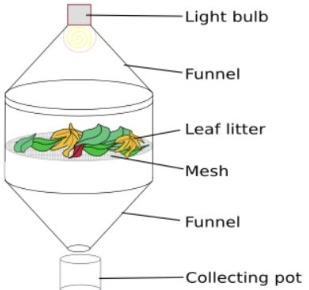
sampling plants
sampled using quadrats:
point quadrat→ frame with pins placed through at regular intervals. Each species the pin touches is counted
frame quadrat→ square frame divided into equal grid. Type and number of each species are recorded
mark, release, recapture method
used for larger animals
set of animals caught and marked
released back into community
after specified length of time, community is revisited and same number of individuals are caught again
number of marked individuals are counted.
calculating population size from MRR

Assumptions made when using MRR
no migration into or out of the population
mix randomly
marks not lost
marks do not cause harm or increase chance of being caught by predator
marks do not increase chance of recapture
reliability
how consistently a method measures something
reducing effects of sampling bias
use random number generation
larger sample size
why is biodiversity measured
conservation and environmental management→ impact of a factor on abundance of species
indicates stability of an ecosystem
simpson’s index of biodiversity
0= no diversity
1= infinite diversity
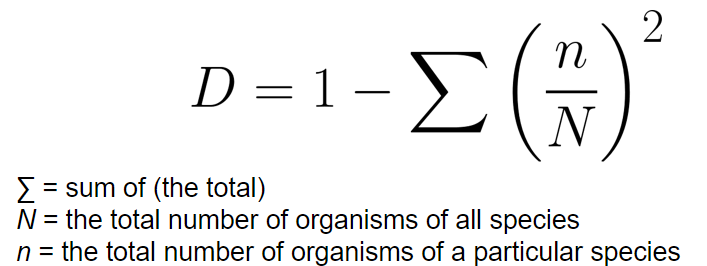
what do levels of biodiversity tell us?
Low biodiversity:
few species
stressful/extreme environment
very specific adaptations
simple food webs
change=major effect on ecosystem
high biodiversity:
large number of species
not stressful environment
many species live in habitat→ few specific adaptations
complex food webs
change= small effect on ecosystem
what does genetic diversity depend on
the number of different alleles in a species:
greater number of alleles= greater genetic diversity
fewer alleles= reduced genetic diversity
why is genetic diversity important
more genetic diversity= more alleles= more variation= greater chance of individuals surviving environmental change
factors affecting genetic diversity
increasing:
mutations
interbreeding and gene flow
decrease:
selective breeding
captive breeding programs
cloning
natural selection
genetic bottlenecks
founder effect
genetic drift
mutations
bring about new alleles for a gene
alleles can be passed onto offspring
interbreeding and gene flow
gene flow→ when animal migrates from one pop. to another
increases allele frequency of the new population
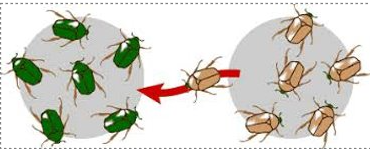
selective breeding and captive breeding
reduces number of alleles in a population as favoured alleles are consistently being bred until individuals with other alleles become reduced
in captive breeding, fewer individuals available to be bred together so reduced gene pool
cloning
identical genes to the parent sample= no genetic diversity
natural selection
as advantageous characteristics are favoured, other alleles from the population will be lost
genetic bottlenecks
sudden large reduction in pop. size= fewer alleles present
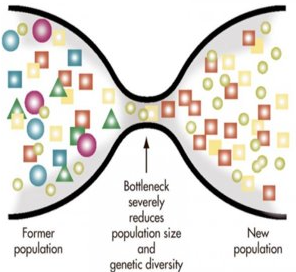
founder effect
when a few individuals from the original population start a new colony→ few alleles in the new gene pool
genetic drift
when chance dictates which organisms survive and reproduces→ occurs randomly
larger impact seen on small populations

polymorphism
when a gene has more than one allele e.g. hair colour
monomorphism
when a gene has only one allele- ensures that basic structure of species is similar
calculating genetic diversity
number of polymorphic gene loci/total number of loci